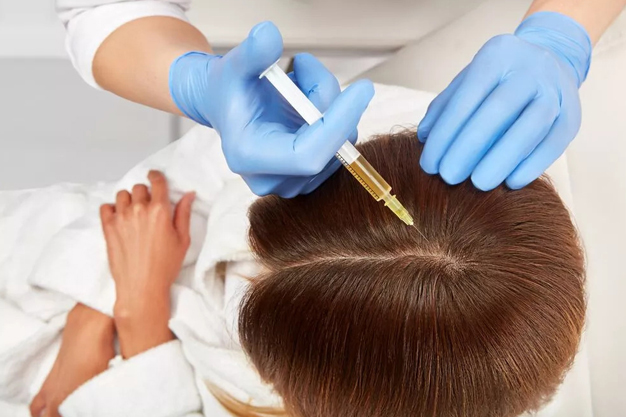Hair loss can be a deeply personal concern for women, impacting confidence and self-esteem. While traditionally associated with men, Hair Transplants in Ajman & Fujairah are becoming an increasingly popular solution for women in Ajman and Fujairah seeking to restore their natural hairlines and achieve thicker, fuller hair.
Understanding Female Hair Loss:
Female hair loss can present differently than in men. It often manifests as gradual thinning across the scalp rather than a receding hairline. Common causes include:
Telogen effluvium: A temporary shedding phase triggered by stress, childbirth, or hormonal changes.
Androgenetic alopecia (female pattern hair loss): This hereditary condition is influenced by androgens (male hormones) and can be progressive.
Traction alopecia: Tight hairstyles or hair treatments can damage follicles and lead to hair loss.
Alopecia areata: An autoimmune disease causing patchy hair loss.

Hair Transplant Techniques for Women:
Fortunately, modern hair transplant techniques offer effective solutions for women in Ajman and Fujairah. Here are the two main methods:
Follicular Unit Extraction (FUE): This minimally invasive technique extracts individual follicular units from the donor area (usually the back of the scalp) and transplants them to the balding or thinning areas. FUE leaves minimal scarring, making it ideal for women who desire a natural-looking result.
Follicular Unit Transplantation (FUT): This strip harvesting technique removes a thin strip of scalp from the donor area. The follicles are then dissected into individual units for transplantation. FUT can be less expensive than FUE, but it leaves a linear scar that may require careful hairstyling to conceal.
Consultation and Planning for Women:
A comprehensive consultation with a qualified hair transplant surgeon in Ajman or Fujairah is crucial. The surgeon will assess your hair loss pattern, scalp health, and overall health to determine if you’re a suitable candidate for a hair transplant. During the consultation, discuss your desired outcome, hair density goals, and any concerns you may have.
The surgeon will also explain the specific technique recommended for your case and provide a detailed plan for the procedure, including the number of grafts needed and the expected recovery timeline.
Considerations for Women Undergoing Hair Transplants:
Here are some key factors for women in Ajman and Fujairah to consider when undergoing a hair transplant:
Donor area density: The density of hair follicles in the donor area will determine how many grafts can be extracted for transplantation.
Hair calibre and texture: Women often have finer hair than men. Matching the calibre and texture of the transplanted hair to your existing hair is essential for a natural appearance.
Scalp laxity: Scalp laxity (looseness) can influence the placement and direction of transplanted follicles for women.
Advantages of Hair Transplants for Women:
Hair transplants offer several benefits for women in Ajman and Fujairah experiencing hair loss:
Permanent hair restoration: Unlike temporary solutions like wigs or hair thickening products, hair transplants offer a long-term solution for hair loss.
Improved self-confidence: Regaining a fuller head of hair can significantly boost self-confidence and self-esteem.
Natural-looking results: With proper planning and skilled technique, hair transplants can achieve a natural and aesthetically pleasing hairline and hair density.
Minimal scarring: FUE hair transplants leave minimal to no visible scarring, making them ideal for women who want to maintain a variety of hairstyles.
Recovery after Hair Transplants for Women:
The recovery process for women after hair transplants in Ajman or Fujairah is typically straightforward. You may experience swelling, redness, and scabbing at the recipient and donor sites for a few days. Most women can return to work and resume normal activities within a week or two.
Following the surgeon’s post-operative instructions carefully is crucial for optimal healing and successful results. This may involve avoiding strenuous activity, wearing a loose-fitting hat, and using prescribed medications.
Potential Side Effects and Risks:
As with any surgical procedure, hair transplants carry some potential side effects and risks. These may include:
Bleeding: Minor bleeding is possible at the donor and recipient sites.
Infection: Proper sterile technique during surgery minimizes this risk.
Scarring: FUT can leave a linear scar, while FUE scarring is minimal.
Unnatural hair growth: Careful planning and placement of grafts minimize this risk.
It’s important to openly discuss all potential risks and side effects with your surgeon during the consultation.
Transplants for Women in Ajman & Fujairah:
The chosen technique: FUE is generally more expensive than FUT.
Surgeon’s experience and qualifications: More experienced surgeons may command higher fees.
Clinic facilities and amenities: Clinics with advanced equipment and luxurious facilities may have a higher cost.
While hair transplants can be an investment, many clinics in Ajman and Fujairah offer financing options to make the procedure more accessible.
Finding the Right Hair Transplant Clinic for Women:
Choosing a reputable and experienced hair transplant clinic in Ajman or Fujairah is critical for women seeking optimal results and a safe experience. Here are some key factors to consider:
Board certification of the surgeon: Ensure the surgeon performing the procedure is board-certified in dermatology or plastic surgery and has extensive experience with hair transplants, particularly for women.
Clinic’s reputation and accreditations: Research the clinic’s reputation, read patient reviews, and look for accreditations from recognized organizations.
Focus on female hair loss: Choose a clinic with a proven track record of successful hair transplants for women.
Transparency in pricing and consultations: Ensure the clinic provides transparent pricing information and thorough consultations where all your questions are addressed.
Hair Transplant Success Stories for Women:
Many women in Ajman and Fujairah have achieved significant hair restoration and improved self-confidence through hair transplants. Before-and-after photos on a clinic’s website or social media pages can showcase the potential results for women with similar hair loss patterns.
Additional Considerations for Women;
Hair coloring: Discuss hair coloring options with your surgeon after the transplant, as some dyes may need to be avoided for a period.
Hormonal fluctuations: If your hair loss is linked to hormonal changes, such as menopause, discuss this with your surgeon to determine if a hair transplant is suitable.
Maintaining healthy hair: Following a healthy lifestyle with a balanced diet and proper hair care routine can support long-term hair health after a transplant.
Conclusion:
Hair transplant offer a viable and long-lasting solution for women in Ajman and Fujairah experiencing hair loss. By choosing a qualified surgeon, the right technique, and prioritizing a healthy lifestyle, women can regain a full head of hair and the confidence that comes with it.







